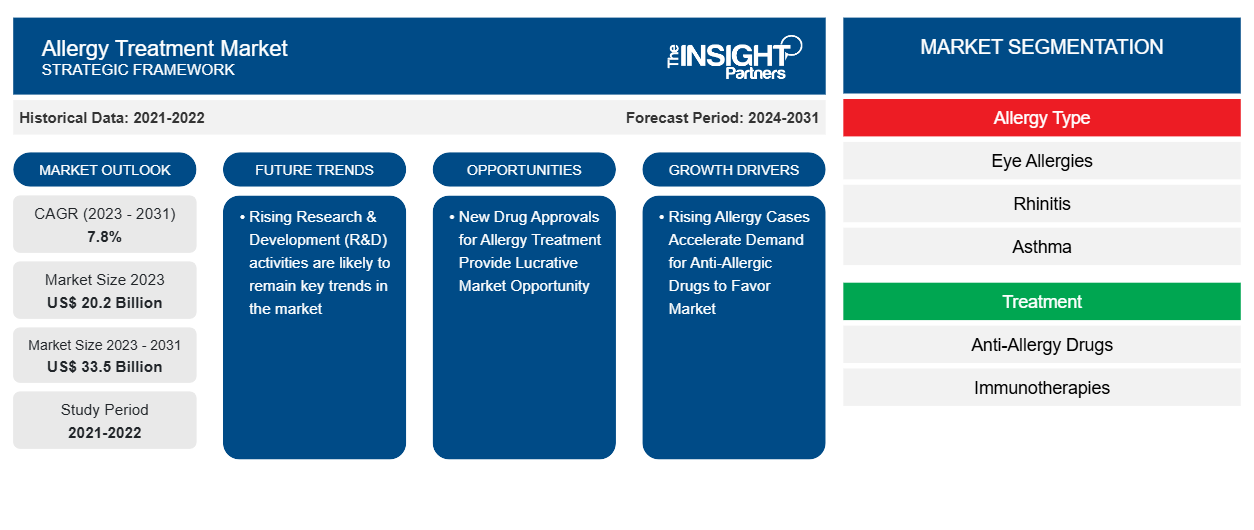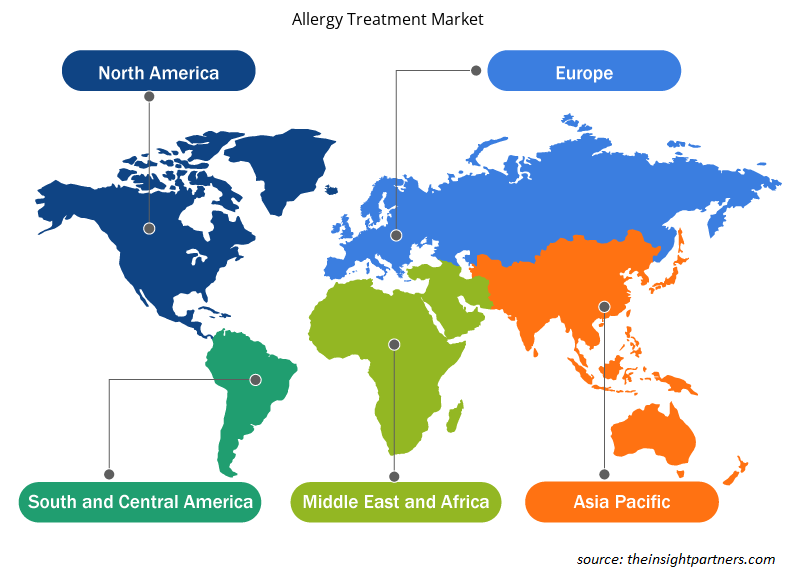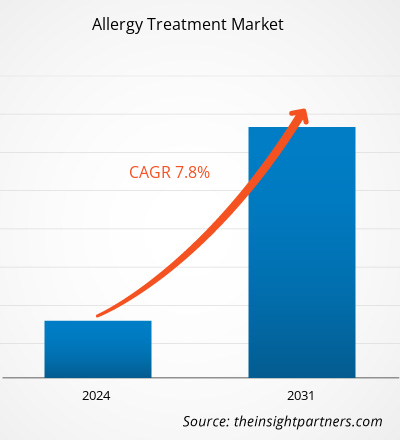The allergy treatment market size is projected to reach US$ 33.5 billion by 2031 from US$ 20.2 billion in 2023. The market is expected to register a CAGR of 7.8% during 2023–2031. Rising Research & Development (R&D) activities are likely to remain key trends in the market.
Allergy Treatment Market Analysis
Rising R&D activities for allergy treatment to develop innovative drugs is likely to remain as a new market trend in the coming years. Despite several allergic medicines in the market, still many patients with respiratory allergies and asthma are not adequately controlled or are insufficiently treated with symptomatic therapy. For example, several respiratory allergies are a risk of developing asthma. Therefore, several top manufacturers are designing clinical trial programs for allergies. HAL Allergy B.V.'s "Allergen Immunotherapies" for respiratory allergies for a clinical trial is an example. Therefore, rising R&D activities will result in the development of novel anti-allergic drugs will account considerable market growth during 2021-2031.
Allergy Treatment Market Overview
According to the Asthma Allergy Clinic report, new data published by the World Allergy Organization (WAO) reveals that 14% of people have asthma, with 20% suffering from allergic rhinitis (AR), which results in IgE-mediated inflammation of the nasal mucosa. Currently, about 20-30% of the people in India have one or more allergic diseases, and the prevalence will rise in the coming years. Therefore, rising cases of allergies will accelerate demand for antiallergic drugs in the coming decade.
Customize This Report To Suit Your Requirement
You will get customization on any report - free of charge - including parts of this report, or country-level analysis, Excel Data pack, as well as avail great offers and discounts for start-ups & universities
Allergy Treatment Market: Strategic Insights

- Get Top Key Market Trends of this report.This FREE sample will include data analysis, ranging from market trends to estimates and forecasts.
You will get customization on any report - free of charge - including parts of this report, or country-level analysis, Excel Data pack, as well as avail great offers and discounts for start-ups & universities
Allergy Treatment Market: Strategic Insights

- Get Top Key Market Trends of this report.This FREE sample will include data analysis, ranging from market trends to estimates and forecasts.
Allergy Treatment Market Drivers and Opportunities
Rising Allergy Cases Accelerate Demand for Anti-Allergic Drugs to Favor Market
According to the American Academy of Pediatrics report, the most common type of allergy is Hay Fever (allergic rhinitis), which accounts for the high cost of treatment. For example, the direct and indirect costs exceed US$7 billion annually for allergy treatment. Therefore, good allergy treatment is based on medical history, results of allergy tests, and with symptoms mild or severe. Additionally, immunotherapy is an effective treatment option for some allergy patients. There are two common types of immunotherapy. These include allergy shots and sublingual immunotherapy (SLIT). Allergy shots include giving injection of allergens with; an increasing dose over time. Also, the person progressively less sensitive to that allergen as these shots can work well for some people with allergies to pollen, pets, dust, bees, and other stinging insects, as well as asthma. Therefore, rising allergy cases accelerate demand for anti-allergic drugs acting as the major drivers for global allergy treatment market share.
New Drug Approvals for Allergy Treatment Provide Lucrative Market Opportunity
New drug approvals to treat allergy treatments will provide lucrative market opportunity for the allergy treatment market. In June 2020, Cadila Pharmaceuticals Limited announced the launching of "Bilastine Syrup (30ml)" and Bilastine Tablets of 20mg strength. Additionally, in March 2022, Perrigo Company plc announced receiving final approval from the USFDA for over-the-counter (OTC) use of "Nasonex® 24HR Allergy (mometasone furoate monohydrate 50mcg)". The approval marks the first branded Rx-to-OTC switch for the company for "Nasonex" to enter the OTC marketplace.
Allergy Treatment Market Report Segmentation Analysis
Key segments that contributed to the derivation of the allergy treatment market analysis are type, cause, disorder type, category, and end user.
- Based on allergy type, the allergy treatment market is segmented as eye allergies, rhinitis, asthma, skin allergies, food allergies, and others. The rhinitis segment held a larger market share in 2023.
- By treatment, the market is segmented into anti-allergy drugs and immunotherapies. The anti-allergy drugs segment held the largest share of the market in 2023.
Allergy Treatment Market Share Analysis by Geography
The geographic scope of the Allergy Treatment market report is mainly divided into five regions: North America, Asia Pacific, Europe, Middle East & Africa, and South & Central America.
North America has dominated the market. In North America region, the US accounts largest share for allergy treatment market. Presence of top manufacturers in the region and their innovative anti-allergic drugs having effective pharmacological activity are the factors contributing to the dominance of the market. Asia Pacific is anticipated to grow with the highest CAGR in the coming years.
Allergy Treatment Market Regional Insights
The regional trends and factors influencing the Allergy Treatment Market throughout the forecast period have been thoroughly explained by the analysts at The Insight Partners. This section also discusses Allergy Treatment Market segments and geography across North America, Europe, Asia Pacific, Middle East and Africa, and South and Central America.

- Get the Regional Specific Data for Allergy Treatment Market
Allergy Treatment Market Report Scope
| Report Attribute | Details |
|---|---|
| Market size in 2023 | US$ 20.2 Billion |
| Market Size by 2031 | US$ 33.5 Billion |
| Global CAGR (2023 - 2031) | 7.8% |
| Historical Data | 2021-2022 |
| Forecast period | 2024-2031 |
| Segments Covered |
By Allergy Type
|
| Regions and Countries Covered | North America
|
| Market leaders and key company profiles |
Allergy Treatment Market Players Density: Understanding Its Impact on Business Dynamics
The Allergy Treatment Market is growing rapidly, driven by increasing end-user demand due to factors such as evolving consumer preferences, technological advancements, and greater awareness of the product's benefits. As demand rises, businesses are expanding their offerings, innovating to meet consumer needs, and capitalizing on emerging trends, which further fuels market growth.
Market players density refers to the distribution of firms or companies operating within a particular market or industry. It indicates how many competitors (market players) are present in a given market space relative to its size or total market value.
Major Companies operating in the Allergy Treatment Market are:
- Johnson and Johnson Services, Inc.
- Sanofi
- AbbVie, Inc. (Allergan plc)
- Pfizer, Inc.
- LETIPharma
- ALK-Abello A/S
Disclaimer: The companies listed above are not ranked in any particular order.

- Get the Allergy Treatment Market top key players overview
Allergy Treatment Market News and Recent Developments
The Allergy Treatment market is evaluated by gathering qualitative and quantitative data post primary and secondary research, which includes important corporate publications, association data, and databases. A few of the developments in the Allergy Treatment market are listed below:
- In February 2024, Novartis announced US Food and Drug Administration (USFDA) approval of "Xolair (omalizumab)". The newly launched product is used for the reduction of allergic reactions, including anaphylaxis occurring with accidental exposure to one or more foods in adult and paediatric patients aged 1 year and older with IgE-mediated food allergy. (Source: Novartis, Company Website, February 2024)
Allergy Treatment Market Report Coverage and Deliverables
The “Allergy Treatment Market Size and Forecast (2021–2031)” report provides a detailed analysis of the market covering below areas:
- Allergy treatment market size and forecast at global, regional, and country levels for all the key market segments covered under the scope
- Allergy Treatment market trends as well as market dynamics such as drivers, restraints, and key opportunities
- Detailed PEST/Porter’s Five Forces and SWOT analysis
- Allergy Treatment market analysis covering key market trends, global and regional framework, major players, regulations, and recent market developments
- Industry landscape and competition analysis covering market concentration, heat map analysis, prominent players, and recent developments for the Allergy Treatment market
- Detailed company profiles
Frequently Asked Questions
Which region dominated the allergy treatment market in 2023?
North America region dominated the allergy treatment market in 2023.
What are the driving factors impacting the allergy treatment market?
Rising allergy cases accelerate demand for anti-allergic drugs to favor market is one of the most influential factors responsible for market growth.
What are the future trends of the allergy treatment market?
Rising Research & Development (R&D) activities to remain as a key trend for allergy treatment market.
Which are the leading players operating in the allergy treatment market?
Johnson and Johnson Services, Inc., Sanofi, AbbVie, Inc. (Allergan plc), Pfizer, Inc., LETIPharma, ALK-Abello A/S, Allergy Therapeutics, Stallergenes Greer, GSK, and Dermapharm Holdings are the key players in the allergy treatment market.
What would be the estimated value of the allergy treatment market by 2031?
The estimated value of allergy treatment market accounted US$ 33.5 billion in 2031.
What is the expected CAGR of the allergy treatment market?
The CAGR for allergy treatment accounted 7.8% during 2023-2031.
- Historical Analysis (2 Years), Base Year, Forecast (7 Years) with CAGR
- PEST and SWOT Analysis
- Market Size Value / Volume - Global, Regional, Country
- Industry and Competitive Landscape
- Excel Dataset
Testimonials
Reason to Buy
- Informed Decision-Making
- Understanding Market Dynamics
- Competitive Analysis
- Identifying Emerging Markets
- Customer Insights
- Market Forecasts
- Risk Mitigation
- Boosting Operational Efficiency
- Strategic Planning
- Investment Justification
- Tracking Industry Innovations
- Aligning with Regulatory Trends
Yes! We provide a free sample of the report, which includes Report Scope (Table of Contents), report structure, and selected insights to help you assess the value of the full report. Please click on the "Download Sample" button or contact us to receive your copy.
Absolutely — analyst assistance is part of the package. You can connect with our analyst post-purchase to clarify report insights, methodology or discuss how the findings apply to your business needs.
Once your order is successfully placed, you will receive a confirmation email along with your invoice.
• For published reports: You’ll receive access to the report within 4–6 working hours via a secured email sent to your email.
• For upcoming reports: Your order will be recorded as a pre-booking. Our team will share the estimated release date and keep you informed of any updates. As soon as the report is published, it will be delivered to your registered email.
We offer customization options to align the report with your specific objectives. Whether you need deeper insights into a particular region, industry segment, competitor analysis, or data cut, our research team can tailor the report accordingly. Please share your requirements with us, and we’ll be happy to provide a customized proposal or scope.
The report is available in either PDF format or as an Excel dataset, depending on the license you choose.
The PDF version provides the full analysis and visuals in a ready-to-read format. The Excel dataset includes all underlying data tables for easy manipulation and further analysis.
Please review the license options at checkout or contact us to confirm which formats are included with your purchase.
Our payment process is fully secure and PCI-DSS compliant.
We use trusted and encrypted payment gateways to ensure that all transactions are protected with industry-standard SSL encryption. Your payment details are never stored on our servers and are handled securely by certified third-party processors.
You can make your purchase with confidence, knowing your personal and financial information is safe with us.
Yes, we do offer special pricing for bulk purchases.
If you're interested in purchasing multiple reports, we’re happy to provide a customized bundle offer or volume-based discount tailored to your needs. Please contact our sales team with the list of reports you’re considering, and we’ll share a personalized quote.
Yes, absolutely.
Our team is available to help you make an informed decision. Whether you have questions about the report’s scope, methodology, customization options, or which license suits you best, we’re here to assist. Please reach out to us at sales@theinsightpartners.com, and one of our representatives will get in touch promptly.
Yes, a billing invoice will be automatically generated and sent to your registered email upon successful completion of your purchase.
If you need the invoice in a specific format or require additional details (such as company name, GST, or VAT information), feel free to contact us, and we’ll be happy to assist.
Yes, certainly.
If you encounter any difficulties accessing or receiving your report, our support team is ready to assist you. Simply reach out to us via email or live chat with your order information, and we’ll ensure the issue is resolved quickly so you can access your report without interruption.





















 Get Free Sample For
Get Free Sample For